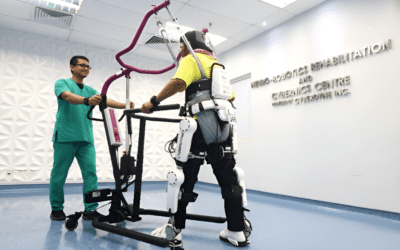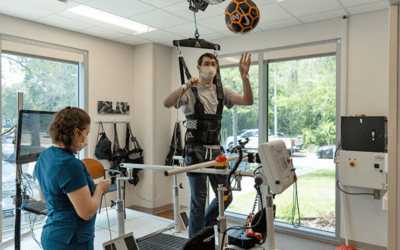Migraine-associated vertigo (MAV), also referred to as vestibular migraine, represents a challenging blend of migraine headaches and vertigo, a sensation of spinning or dizziness. While many are familiar with migraines’ hallmark symptoms—intense headaches, nausea, and heightened sensitivity to light—fewer realize that migraines can also trigger vertigo. For those affected, this dual condition significantly hampers their ability to maintain balance and process sensory inputs. However, advancements in neurorehabilitation therapies offer new hope by targeting the underlying vestibular system dysfunctions that contribute to these symptoms.
What is Migraine-Associated Vertigo?
Migraine-associated vertigo is a condition where vestibular dysfunction coexists with or follows a migraine episode. The vestibular system—responsible for maintaining balance and spatial awareness—is compromised during MAV, causing a range of distressing symptoms that can last for days or even weeks.

Common symptoms of Migraine-Associated Vertigo include:
- Dizziness or Spinning Dizziness: People experience dizziness or spinning although they remain seated.
- Lack of Balance: Inability to walk or stand without falling.
- Hyperacusis: Increased sensitivity to sound.
- Sensitivity to Motion: Greater confusion when moving or even just turning one’s head.
- Visual Hyperacuity: Increased sensitivity to light or motion.
Common Migraine Symptoms:
- Headaches
- nausea
- photophobia and phonophobia however, these are not always present with MAV attacks.
To MAV patients, such complications may make it quite difficult to perform even simple everyday activities as they avoid getting out and about and become anxious due to the risk of falls. Fortunately, neurorehabilitation therapies could also alleviate most of these problems by retraining the brain to improve the handling of vestibular challenges.
Effective Neurorehabilitation Therapies for How to Manage Balance Issues with Migraine-Associated Vertigo
Neurorehabilitation is a multi-component strategy whose nature is directed to rewrite the nervous system into normal functioning. With Migrainous Vertigo, neurorehabilitation is aimed at improving balance, reducing dizziness, and enhancing sensory processing through the natural adapting ability of the brain, neuroplasticity. Using structured exercises and therapies, patients can be able to recalibrate their brain and vestibular systems to reduce MAV’s debilitating symptoms.

Here are some of the most effective neurorehabilitation therapies for MAV:
1. Vestibular Rehabilitation Therapy (VRT)
Vestibular rehabilitation therapy (VRT) is an established treatment tool used to control vertigo and equilibrium problems in patients diagnosed with MAV. This therapy involves reacquiring control over what the brain receives from the vestibular system, eyes, and muscles, encouraging equilibrium and orientation.
Components of VRT
Improve Balancing Ability: Exercises for training require that a client stand or walk on an uneven surface or when the head is moved to help retrain the body on stabilizing self.
Relief for Dizziness: Gaze stabilizing exercises where one might focus on a still object while moving the head can help alleviate dizziness as well as recalculate the brain’s sense of motion.
Strengthen Coordination: Patients improve their capacity for recovery from postural sway and visual changes by means of coordinated eye and head movements.
Patients generally continue with fewer dizziness problems, better balance, and increased confidence in mobility after repeated practice.
2. Visual Therapy for Sensory Improvement
AV About 80% to 85% of patients with MAV complain of ophthalmological disturbances such as inability to pursue objects at motion or sensitivity of eyes to light or inability to focus. The side effects of visual disturbances make the sense of dizziness and distortion worse, thus a specific treatment for these is called visual therapy, which is also known as oculomotor therapy.
A set of exercises in visual therapy includes:
Visual Tracking: Pursuit of moving objects by eyes; this helps improve the coordination of eye movements and lessens vertigo caused by vision.
Eye-Head Coordination: Parallel tasks that involve head movements in addition to eye movement assist the brain to coordinate visual input with balance responses and, therefore, reduce dizziness.
Desensitization to Light: Gradual exposure to bright light stimuli allows patients to decrease their sensitivity to light and become less reactive to visual stimuli.
Patients with enhanced visual processing have reduced disruptions with balance and can stay in spaces rich in movement or bright lighting much more easily.
3. Gait Training for Increased Ambulation
Many MAV patients walk unsteadily or feel off-balance. Neurorehabilitation also includes gait training, which is designed to improve the child’s pattern of walking, posture, and integration movement overall. This is especially important for those who have vestibular symptoms and feel unstable or like they may fall over.
Important Features of Gait Training:
Improved Postural Control: These are exercises that would help to maintain proper alignment and stability while walking.
Weight-Shifting Skills: Teaches the patient to slowly step from one foot to another so that the patient can stabilize himself during ambulation.
Negotiating Various Surfaces: Patients get accustomed to walking on different surfaces such as rough grounds and stairs along with re-gaining confidence and increasing their mobility in difficult situations.
Routine gait practice strengthens muscles and coordinates them, but more importantly, it reduces this paralyzing anxiety and fear of falling that typically go along with MAV.
4. Sensory Integration Therapy
Sensory hypersensitivity is the common, and even disturbing symptom, of MAV. Patients commonly experience that routine sensory stimulation-from sounds to lights or even slight motion-is overwhelming, which further contributes to balance issues and dizziness. Thus, sensory integration therapy aims at reducing the hypersensitivity reaction of the brain for these stimuli by gradually increasing the presentation of sensory inputs.
During sensory integration therapy:
Desensitization Exercise: The brain is able to reset and lessen its over-sensitive response through controlled and progressive exposure to sensory stimulants, such as lights or sounds.
Multisensory Exercise: Multi-sensory exercises- training all of the senses together in therapy intervention can actually exercise ways by which sensory information is better integrated and processed by the brain.
In doing these exercises, the brain can make it learn and pay attention to sensory inputs without dizziness or disorientation, thereby enabling the patient to eventually navigate their own environments.
5. Biofeedback and Neurofeedback: Techniques for How to Manage Balance Issues with Migraine-Associated Vertigo
Biofeedback and neurofeedback are advanced technological approaches to neurorehabilitation. The therapies employ real time monitoring to aid a patient to learn controlling some physiological responses that may be contributing to his migraines or vertigo.
Biofeedback: Patients learn to regulate bodily responses through such things as the tension in their muscles or breathing patterns through biofeedback, in which sensors provide them with real-time information. This should reduce migraine triggers and help control stress or anxiety a common MAV trigger.
Neurofeedback: This is basically brain electrical retraining. Using an EEG sensor, the patient gets feedback on his/her brainwave activity, which will then help him/her learn ways of enhancing relaxation and balance patterns. Such retraining can positively influence vestibular function and make MAV attacks less frequent.
Biofeedback and neurofeedback teach the patient to manage the physiological responses for long-term relief from MAV symptoms
6. Non-Invasive Brain Stimulation (NIBS)
Non-invasive brain stimulation (NIBS), under which TMS falls, is an emerging therapy that may hold hope for the victims of migraine and vertigo. TMS impacts targeted areas of the brain that are primarily in charge of controlling balance, migraine pain, and sensory input.
In MAV, TMS may modulate brain activity to result in a reduction of the intensity of episodes related to migraines and vertigo. The fact that this type of technology is not invasive means that it could open up a route for treatment for patients who have exhausted all avenues of conventional therapy.
Conclusion:
These are very challenging kinds of conditions that both assault balance and sensory processing making it difficult to do anything even in the course of everyday life. However, neurorehabilitation advances have enabled patients to receive more than just suffering in silence. Techniques include vestibular rehabilitation, sensory integration, and also new approaches such as biofeedback which has been offering people different tools that enable them to regain control over their symptoms.
With common therapy and the possibility of neuroplasticity, patients can really experience decreased dizziness, better balance, and improved sensory processing, which subsequently leads to increased quality of life. As techniques in neurorehabilitation continue to advance, the future is indeed very promising for those fighting Migraine-Associated Vertigo.



